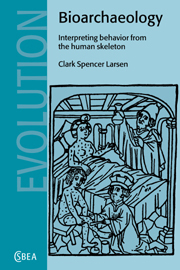Book contents
- Frontmatter
- Contents
- Acknowledgments
- 1 Introduction
- 2 Stress and deprivation during the years of growth and development and adulthood
- 3 Exposure to infectious pathogens
- 4 Injury and violent death
- 5 Activity patterns: 1. Articular and muscular modifications
- 6 Activity patterns: 2. Structural adaptation
- 7 Masticatory and nonmasticatory functions: craniofacial adaptation
- 8 Isotopic and elemental signatures of diet and nutrition
- 9 Historical dimensions of skeletal variation: tracing genetic relationships
- 10 Changes and challenges in bioarchaeology
- References
- General index
- Site index
8 - Isotopic and elemental signatures of diet and nutrition
Published online by Cambridge University Press: 05 June 2012
- Frontmatter
- Contents
- Acknowledgments
- 1 Introduction
- 2 Stress and deprivation during the years of growth and development and adulthood
- 3 Exposure to infectious pathogens
- 4 Injury and violent death
- 5 Activity patterns: 1. Articular and muscular modifications
- 6 Activity patterns: 2. Structural adaptation
- 7 Masticatory and nonmasticatory functions: craniofacial adaptation
- 8 Isotopic and elemental signatures of diet and nutrition
- 9 Historical dimensions of skeletal variation: tracing genetic relationships
- 10 Changes and challenges in bioarchaeology
- References
- General index
- Site index
Summary
Introduction
Documentation of past foodways provides the requisite context for evaluating the effects of nutrition on growth and development, the assessment of stress and disease from paleopathological indicators, and the role of physical activity in the food quest, among other topics discussed in the foregoing chapters. There are a range of conventional approaches for characterizing past diets, including analysis of plant and animal remains, coprolites, and tools used for extracting food from the environment or for processing it once it is acquired. These approaches do not necessarily represent the proportions of foods or food classes consumed by past populations. For example, the notoriously poor preservation of plants in many archaeological contexts can prevent the documentation of their role in diets. Food refuse is often subject to preservation-related biases that confound nutritional interpretation.
Bone chemistry – specifically involving the measurement of stable isotope ratios and elemental (major and trace) constituents in archaeological human skeletons – greatly enhances our ability to characterize past human diets. The reading of chemical signatures passed from the foods being eaten to the consumer allows the documentation of diet. These signatures do not represent a ‘reconstruction’ of diet; rather, they facilitate the identification of consumption profiles of different foods eaten by past populations (Keegan, 1989).
- Type
- Chapter
- Information
- BioarchaeologyInterpreting Behavior from the Human Skeleton, pp. 270 - 301Publisher: Cambridge University PressPrint publication year: 1997



